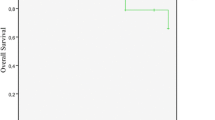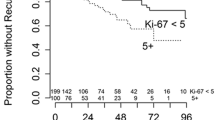Abstract
The World Health Organization (WHO) grading system for meningioma is helpful for predicting aggressive subtypes. However, even benign meningiomas sometimes show relatively rapid growth and may recur after total removal. We attempted to find histopathological features that would be valuable for predicting recurrence or regrowth of WHO grade I meningiomas. We investigated 135 benign meningiomas, of which 120 were totally removed (Simpson’s grade I–III). The median follow-up period was 9.7 years (1–21 years). The recurrence rate in the patients with total removal was 7.5% at 10 years and 9.3% at 20 years. The univariate analysis revealed that MIB-1 index (≥2%), existence of mitosis, absence of calcification, and paucity of fibrosis significantly correlated with recurrence. On the other hand, the histological features of sheet-like growth, prominent nucleoli, and necrosis did not correlate with recurrence, because they were relatively rare in grade I tumors. Multivariate analysis revealed that high MIB-1 index and absence of calcification significantly correlated with recurrence. The patients with recurrent or residual tumors did not always receive adjuvant treatment. Including subtotally treated tumors, the retreatment rate was 9.8% at 10 years and 25.6% at 20 years. MIB-1 index and Simpson’s grade significantly correlated with retreatment in both univariate and multivariate analyses.
Similar content being viewed by others
References
Ho DM, Hsu CY, Ting LT, et al (2002) Histopathology and MIB-1 labeling index predicted recurrence of meningiomas: a proposal of diagnostic criteria for patients with atypical meningioma. Cancer (Phila) 94:1538–1547
Jääskeläinen J, Haltia M, Servo A (1986) Atypical and anaplastic meningiomas: radiology, surgery, radiotherapy, and outcome. Surg Neurol 25:233–242.
Perry A, Salford SI, Sceithauer BW, et al (1997) Meningioma grading. An analysis of histologic parameters. Am J Surg Pathol 21:1455–1465
Louis DN, Scheithauer BW, von Deimling A, et al (2000) Meningiomas. In: Kleiheus P, Cavenee WK (eds) WHO classification of tumours of the central nervous system. IARC, Lyon, pp 176–184
Perry A, Louis DN, Scheithauer BW, et al (2007) Meningioma. In: Louis DN, Ohgaki H, Wiestler OD, Caveneee WK (eds) WHO classification of tumours of the central nervous system. IARC, Lyon, pp 163–172
Kasuya H, Kubo O, Tanaka M, et al (2006) Clinical and radiological features related to the growth potential of meningioma. Neurosurg Rev 29:293–296
Nakasu S, Nakajima M, Matsumura K, et al (1995) Meningioma: proliferating potential and clinicoradiological features. Neurosurgery 37:1049–1055
Maiuri F, Iaconetta G, de Divitiis O, et al (1999) Intracranial meningiomas: correlations between MR imaging and histology. Eur J Radiol 31:69–75
Soyama N, Kuratsu J, Ushio Y (1995) Correlation between magnetic resonance images and histology in meningiomas: T2-weighted images indicate collagen contents in tissues. Neurol Med Chir 35:438–441
Suzuki Y, Sugimoto T, Shibuya M, et al (1994) Meningiomas: correlation between MRI characteristics and operative finding including consistency. Acta Neurochir 129:39–46
Nakasu S, Li D-H, Okabe H, et al (2001) Significance of MIB-1 staining indices in meningiomas. Comparison of two counting methods. Am J Surg Pathol 25:472–478
Simpson D (1957) The recurrence of intracranial meningiomas after surgical treatment. J Neurol Neurosurg Psychiatry 20:22–39
Vankalakuniti M, Vasishta RK, das Rodorta B, et al (2007) MIB-1 immunolabeling: a valuable marker in prediction of benign recurring meningiomas. Neuropathology 27:407–412
Roser F, Samii M, Ostertag H, et al (2004) The Ki-67 proliferation antigen in meningiomas. Experience in 600 cases. Acta Neurochir (Wien) 146:37–44
Takeuchi H, Kubota T, Kabuto M, et al (1997) Prediction of recurrence in histologically benign meningiomas: proliferating cell nuclear antigen and Ki-67 immunohistochemical study. Surg Neurol 48:501–508
Takahashi JA, Ueba T, Hashimoto N, et al (2004) The combination of mitotic and Ki-67 indices as a useful method for predicting short-term recurrence of meningiomas. Surg Neurol 61:149–155
Tyagi A, Chakrabarty A, Franks A (2004) MIB1 proliferation index in meningiomas: does it predict recurrence? A clinicopathological study. Br J Neurosurg 18:357–361
Maiuri F, DeCaro Model B, Esposito F, et al (2007) Recurrences of meningiomas: predictive value of pathological features and hormonal and growth factor. J Neuro-Oncol 82:63–68
Matsuno A, Fujimaki T, Sasaki T, et al (1996) Clinical and histopathological analysis of proliferative potentials of recurrent and non-recurrent meningiomas. Acta Neuropathol (Berl) 91:504–510
Kim YJ, Ketter R, Steudel WI, et al (2007) Prognostic significance of the mitotic index using the mitosis marker anti-phosphohistone H3 in meningiomas. Am J Clin Pathol 128:118–125
Rezanko T, Akkalp AK, Tunakan M, et al (2008) MIB-1 counting methods in meningiomas and agreement among pathologists. Anal Quant Cytol Histol 30:47–52
Kim YJ, Ketter R, Henn W, et al (2006) Histopathologic indicators of recurrence in meningiomas: correlation with clinical and genetic parameters. Virchows Arch 449:529–538
Pfisterer WK, Coons SW, Aboul-Enein F, et al (2008) Implicating chromosomal aberrations with meningioma growth and recurrence: results from FISH and MIB-1 analysis of grade I and II meningioma tissue. J Neuro-Oncol 87:43–50
Maillo A, Orfao A, Espinosa AB, et al (2007) Early recurrences in histologically benign/grade I meningiomas are associated with large tumors and coexistence of monosomy 14 and del(1p36) in the ancestral tumor cell clone. Neurooncology 9:438–446
Author information
Authors and Affiliations
Corresponding author
Rights and permissions
About this article
Cite this article
Nakasu, S., Fukami, T., Jito, J. et al. Recurrence and regrowth of benign meningiomas. Brain Tumor Pathol 26, 69–72 (2009). https://doi.org/10.1007/s10014-009-0251-2
Received:
Accepted:
Published:
Issue Date:
DOI: https://doi.org/10.1007/s10014-009-0251-2




